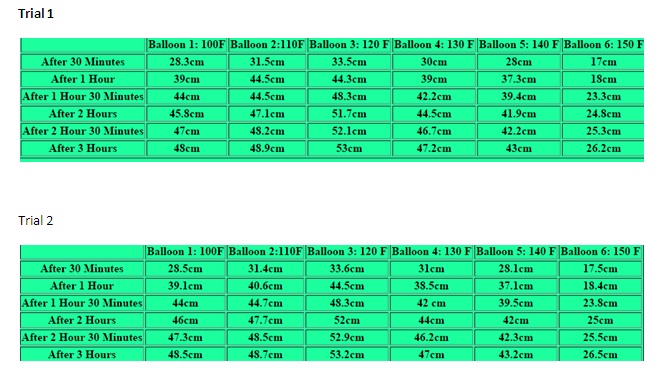





Published on Sep 16, 2023
The objective: The purpose of my project is to determine how temperature affects yeast’s ability to produce carbon dioxide.I used measuring cup,water, a pot,use of a stovetop,thermometer, balloons,12 packets of active dry yeast, sugar, measuring spoons,water bottles,cloth tape measure,pencil and paper.
To determine how temperature affects yeast’s ability to produce carbon dioxide
The warm water will blow up the balloon but cold or very hot water will not.
1. Measuring cup
2. Water
3. A pot
4. Use of a stovetop
5. Thermometer
6. Balloon
7. 12 packets of active dry yeast
8. Sugar
9. Measuring spoons
10. Water bottles
11. Cloth tape measure
12. Pencil and Pape
Heat 1 cup (250 mL) of water on stove. Place the thermometer in the heated water, and turn off the water once the water reaches off 100°F(37.8°C).
As the water is heating up, stretch out your balloon, blow it up, and let the air out. Do this several times. This will make it easier for the gas to push the walls of the balloon.
Quickly put one packet of yeast and 2 tablespoons (30 g) of sugar in the measuring cup. Pour in one cup of warm water, and let the sugar and yeast dissolve.
Pour the dissolved mixture into the empty bottle, and quickly attach the balloon to the bottle’s mouth.
Wait 30 minutes. Measure the circumference of the balloon with the cloth tape measure. Record the measurement.
Wait another 30 minutes and measure again to see if the yeast is still at work. Record the measurement.
Keep measuring every 30 minutes until the balloon stops inflating. If the balloon doesn’t inflate at all, write down zero as a result.
Repeat the steps 1 to 7 at least one more time with the water at the same temperature. Use a new balloon each time. Make sure it’s the exact same size and the type of balloon as the last one you used.
Repeat steps 1 to 8 with the water following temperatures: 110 F (43.3 C), 120 F (48.9°C), 130°F (54.4°C), 140°F(60°C), 150°F (65.6°C). Do each temperature at least twice, and average your results.


From the observations, we can conclude that the yeast worked most effectively when water at a specific temperature is added to it. If the temperature of water is below this, the yeast will not be activated. If the temperature of this water is above this, the water will kill the yeast.
Curtis, Rick. (1998). The Backpacker's Field Manual. Random House: N/A. OA Guide to Water Purification.
Helmenstine, Anne Marie. (N/A). What is Activated Charcoal and How does it Work?. N/A: N/A. November 13, 2013.
N/A. (2013). Back Country Water Treatment. Mountain Equipment Co-op: N/A. November 13, 2013.
N/A. (2013). Water: Purification Methods. National Geographic: N/A. November 13, 2013.
N/A. (2013). Water Disinfection. Centers for Disease Control and Prevention: N/A. November 13, 2013.
N/A. (N/A). Escherichia coli. redOrbit: N/A. December 29, 2013.
N/A. (N/A). Tryptic Soy Agar (TSA). Hardy diagnostics: Santa Maria, California, USA. December 29, 2013.